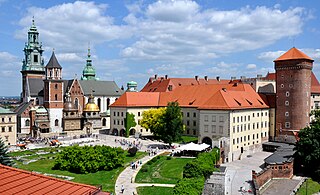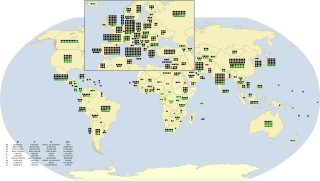| Name | Image | Location | Date | UNESCO data | Description |
|---|
| Historic Centre of Kraków | 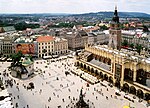 | Kraków
50°04′01″N19°57′36″E / 50.067°N 19.96°E / 50.067; 19.96 (Cracow's Historic Centre) | 11th–19th century | 29; 1978;
iv | Kraków Old Town is the historic central district of Kraków, Poland. [4] It is one of the most famous old districts in Poland today and was the center of Poland's political life from 1038 until King Sigismund III Vasa relocated his court to Warsaw in 1596. The entire medieval old town is among the first sites chosen for the UNESCO's World Heritage List, inscribed as Cracow's Historic Centre. [5] [6] |
| Wieliczka and Bochnia Royal Salt Mines | 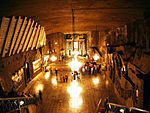 | Wieliczka
49°58′45″N20°03′50″E / 49.979167°N 20.063889°E / 49.979167; 20.063889 (Wieliczka Salt Mine) | 13th-20th century | 32; 1978;
iv | The Wieliczka Salt Mine, located in the town of Wieliczka in southern Poland, lies within the Kraków metropolitan area. The mine continuously produced table salt from the 13th century until 2007 as one of the world's oldest operating salt mines, for most of this time span being a part of the undertaking żupy krakowskie. It is believed to be the world's 14th-oldest company. |
| Auschwitz Birkenau, German Nazi Concentration and Extermination Camp (1940–1945) [7] |  | Oświęcim
50°02′09″N19°10′42″E / 50.035833°N 19.178333°E / 50.035833; 19.178333 (Auschwitz Birkenau German Nazi Concentration and Extermination Camp (1940–1945)) | 1940-1945 | 31; 1979;
vi | Auschwitz was a network of Nazi concentration and extermination camps built and operated by the Third Reich in Polish areas annexed by Nazi Germany during World War II. It was the largest of the German concentration camps, consisting of Auschwitz I (the Stammlager or base camp); Auschwitz II–Birkenau (the Vernichtungslager or extermination camp); Auschwitz III–Monowitz, also known as Buna–Monowitz (a labor camp); and 45 satellite camps. [8] |
| Białowieza Forest |  | Belarus and Poland
52°40′00″N23°50′00″E / 52.666667°N 23.833333°E / 52.666667; 23.833333 (Belovezhskaya Pushcha / Białowieża Forest) | N/A | 33; 1979;
vii | The Białowieża Forest is an ancient woodland straddling the border between the two countries, located 70 km (43 mi) north of Brest (Belarus) and 62 km (39 mi) south-east of Białystok (Poland). It is one of the last and largest remaining parts of the immense primeval forest which once spread across the European Plain. The first recorded piece of legislation on the protection of the forest dates to 1538, when a document issued by King Sigismund I the Old instituted the death penalty for poaching a wisent (European bison). |
| Historic Centre of Warsaw |  | Warsaw
52°14′59″N21°00′44″E / 52.2498°N 21.0122°E / 52.2498; 21.0122 (Historic Centre of Warsaw) | 13th–20th century | 30; 1980;
ii, vi | Warsaw's Old Town was established in the 13th century. Initially surrounded by an earthwork rampart, prior to 1339 it was fortified with brick city walls. The town originally grew up around the castle of the Dukes of Mazovia that later became the Royal Castle. The Market Square (Rynek Starego Miasta) was laid out sometime in the late 13th or early 14th century, along the main road linking the castle with the New Town to the north. |
| Old City of Zamość |  | Zamość
50°43′14″N23°15′31″E / 50.720556°N 23.258611°E / 50.720556; 23.258611 (Old City of Zamość) | 1582–17th century | 564; 1992;
iv | Jan Zamoyski commissioned the Italian architect Bernardo Morando to design the city that would be based on the anthropomorphic concept. The main distinguishing features of the Old Town have been well preserved since its establishment. It includes the regular Great Market Square of 100 x 100 meters with the splendid Townhall and so-called Armenian houses, as well as the fragments of the original fortress and fortifications, including those from the period of the Russian occupation in the 19th century. [9] |
| Castle of the Teutonic Order in Malbork | 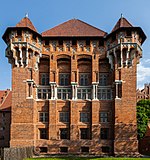 | Malbork
54°02′23″N19°01′40″E / 54.039722°N 19.027778°E / 54.039722; 19.027778 (Castle of the Teutonic Order in Malbork) | 13th-14th century | 847; 1997;
ii, iii, iv | The Castle in Malbork is the largest castle in the world by area. [10] It was built in Prussia by the Teutonic Knights, a German Roman Catholic religious order of crusaders, in a form of an Ordensburg fortress. The Order named it Marienburg (Mary's Castle). The town which grew around it was also named Marienburg. The castle is a classic example of a medieval fortress, and on its completion in 1406 was the world's largest brick Gothic castle. |
| Medieval Town of Toruń |  | Toruń
53°02′00″N18°37′00″E / 53.033333°N 18.616667°E / 53.033333; 18.616667 (Medieval Town of Toruń) | 12th–15th century | 835; 1997;
ii, iv | Toruń has many monuments of architecture beginning from the Middle Ages, including 200 military structures. The city is famous for having preserved almost intact its medieval spatial layout and many Gothic buildings, all built from brick, including monumental churches, the Town Hall and many burgher houses. In 1236, due to frequent flooding, [11] the city was relocated to the present site of the Old Town. In 1264 the nearby New Town was founded. In 1280, the city (or as it was then, both cities) joined the mercantile Hanseatic League, and thus became an important medieval trade centre. |
| Kalwaria Zebrzydowska: the Mannerist Architectural and Park Landscape Complex and Pilgrimage Park |  | Kalwaria Zebrzydowska
49°51′37″N19°40′15″E / 49.860319°N 19.670719°E / 49.860319; 19.670719 (Kalwaria Zebrzydowska: the Mannerist Architectural and Park Landscape Complex and Pilgrimage Park) | 1605-1632 | 905; 1999;
ii, iv | The town is named after the religious complex (calvary) founded by Governor of Kraków Mikołaj Zebrzydowski on December 1, 1602. The complex is known as the Kalwaria Zebrzydowska park. The city of Zebrzydów was established in 1617 in order to house the growing number of pilgrims visiting the religious complex. |
| Churches of Peace in Jawor and Swidnica |  | Jawor , Świdnica
51°03′14″N16°11′46″E / 51.054°N 16.196°E / 51.054; 16.196 (Churches of Peace in Jawor and Swidnica) | 1654-1657 | 1054; 2001;
iii, iv, vi | The Churches of Peace in Jawor and Świdnica in Silesia were named after the Peace of Westphalia of 1648 which permitted the Lutherans in the Roman Catholic parts of Silesia to build three Evangelical churches from wood, loam and straw outside the city walls, without steeples and church bells. The construction time was limited to one year. |
| Wooden Churches of Southern Lesser Poland |  | Lesser Poland Voivodeship
49°51′34″N20°16′29″E / 49.859444°N 20.274722°E / 49.859444; 20.274722 (Wooden Churches of Southern Lesser Poland) | 15th-18th century | 1053; 2003;
iii, iv | The wooden church style of the region originated in the late Medieval, the late sixteenth century, and began with Gothic ornament and polychrome detail, but because they were timber construction, the structure, general form, and feeling is entirely different from the gothic architecture or Polish Gothic (in stone or brick). |
| Muskauer Park / Park Mużakowski |  | Germany and Poland
51°33′01″N14°43′36″E / 51.550278°N 14.726667°E / 51.550278; 14.726667 (Muskauer Park / Park Mużakowski) | 1815-1844 | 1127; 2004;
i, iv | The Muskau Park is the largest and one of the most famous English gardens of Germany and Poland. Situated in the historic Upper Lusatia region, it covers 3.5 square kilometers (1.4 sq mi) of land in Poland and 2.1 km2 (0.81 sq mi) in Germany. UNESCO added the park to its World Heritage List, as an exemplary example of cross-border cultural collaboration between Poland and Germany. |
| Centennial Hall |  | Wrocław
51°06′26″N17°04′37″E / 51.107222°N 17.076944°E / 51.107222; 17.076944 (Centennial Hall) | 1911-1913 | 1165; 2006;
i, ii, iv | The Centennial Hall (formerly People's Hall) is a historic building in Wrocław. It was constructed according to the plans of architect Max Berg in 1911–1913, when the city was part of the German Empire. As an early landmark of reinforced concrete architecture, it was listed as a UNESCO World Heritage Site. |
| Wooden Tserkvas of Carpathian Region in Poland and Ukraine | 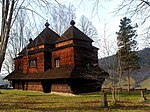 | (Brunary, Chotyniec, Kwiatoń, Owczary, Powroźnik, Radruż Smolnik, Turzańsk) Poland and Ukraine | 16th - 19th century | 1424; 2013;
iii, iv | Situated in the eastern fringe of Central Europe, the transnational property numbers a selection of 16 tserkvas, churches, built of horizontal wooden logs between the 16th and 19th centuries by communities of the Eastern Orthodox and Greek Catholic faiths. They represent the cultural expression of four ethnographic groups and the formal, decorative and technical characteristics they developed over time. The tserkvas bear testimony to a distinct building tradition rooted in Orthodox ecclesiastic design interwoven with elements of local tradition, and symbolic references to their communities’ cosmogony. The tserkvas are built on a tri-partite plan surmounted by open quadrilateral or octagonal domes and cupolas. They feature wooden bell towers, iconostasis screens, and interior polychrome decorations as well as churchyards, gatehouses and graveyards. |
| Tarnowskie Góry Lead-Silver-Zinc Mine and its Underground Water Management System |  | Tarnowskie Góry
50°25′32″N18°50′57″E / 50.4255°N 18.8493°E / 50.4255; 18.8493 (Historic Silver Mine) | 16th century | 1539; 2017;
i, ii, iv | Located in the Upper Silesian region of southern Poland, a major mining area of central Europe, the heritage site "includes the entire underground mine with adits, shafts, galleries and water management system. Most of the site is situated underground while the surface mining topography features the remains of the 19th century steam water pumping station, which testifies to continuous efforts over three centuries to drain the underground extraction zone. It has made it possible to use undesirable water from the mines to supply towns and industry. Tarnowskie Góry represents a significant contribution to the global production of lead and zinc." [12] |
| Krzemionki Prehistoric Striped Flint Mining Region |  | Ostrowiec Świętokrzyski
50°58′4.7″N21°30′8.3″E / 50.967972°N 21.502306°E / 50.967972; 21.502306 (Krzemionki Prehistoric Striped Flint Mining Region) | 3900 BC–1600 BC | 1599; 2019;
iii, iv | A Neolithic and early Bronze Age complex of flint mines for the extraction of Upper Jurassic (Oxfordian) banded flints located about eight kilometers north-east of Ostrowiec Świętokrzyski. It is one of the largest known complex of prehistoric flint mines in Europe together with Grimes Graves in England and Spiennes in Belgium. [13] |




















